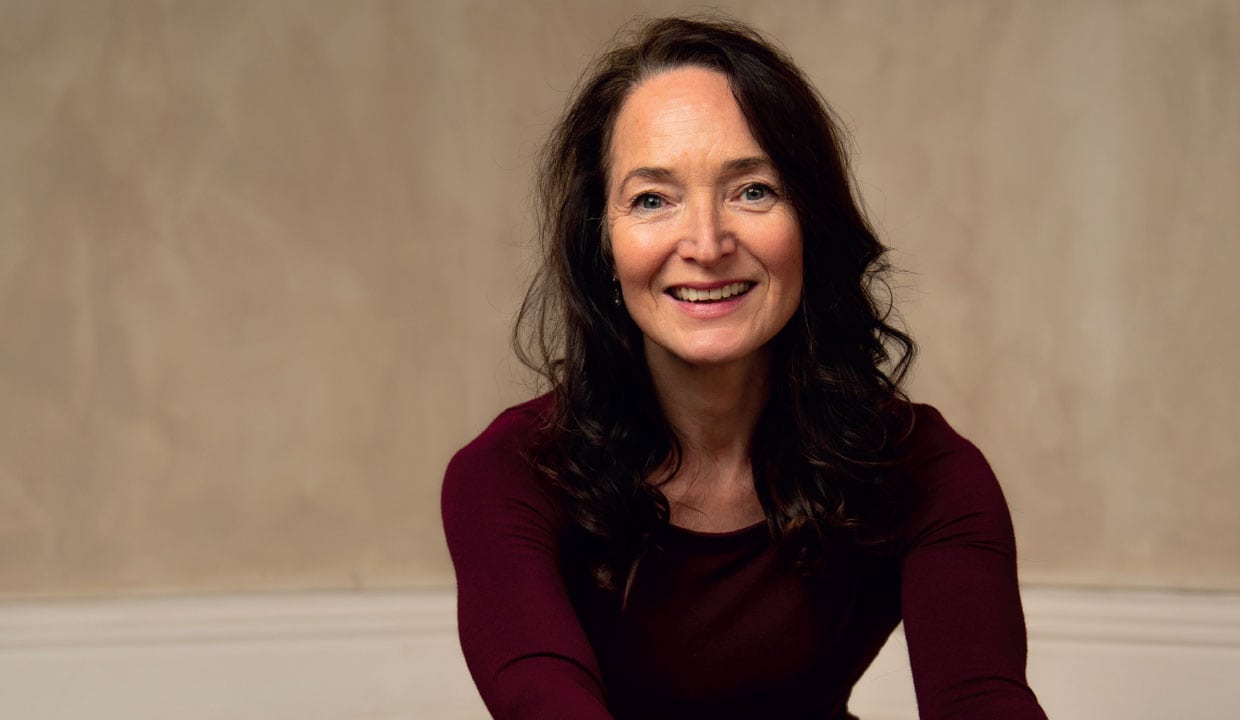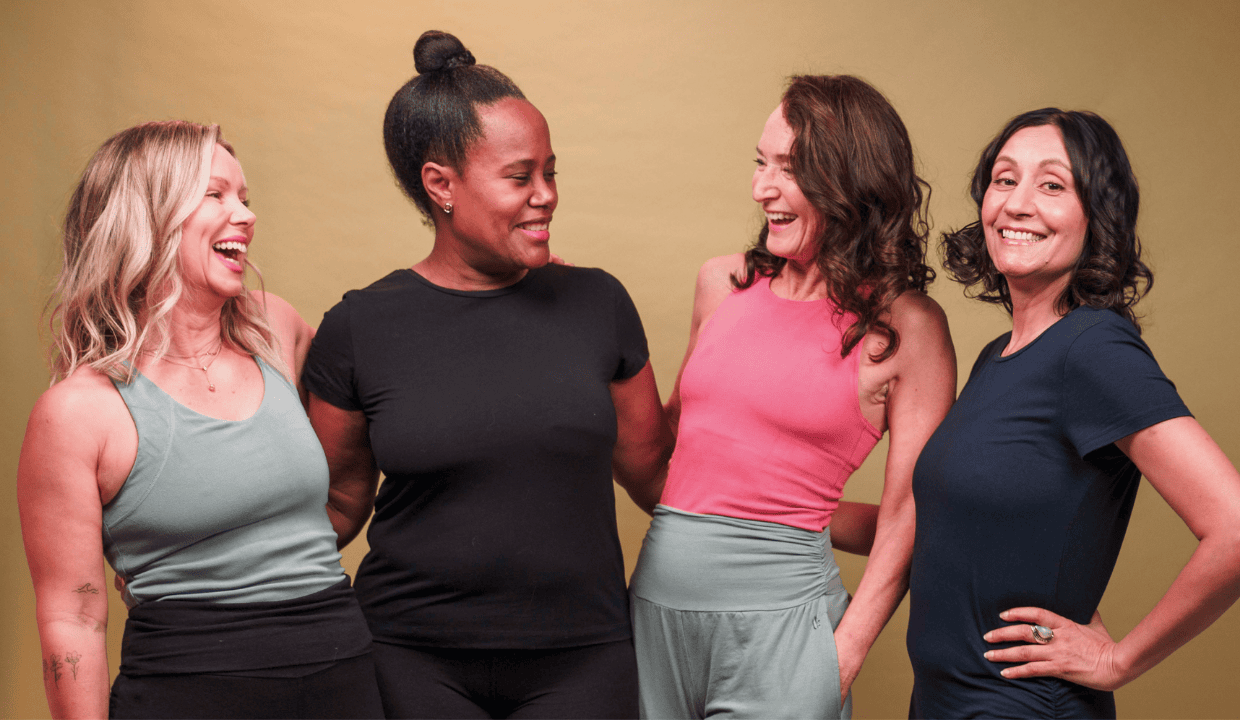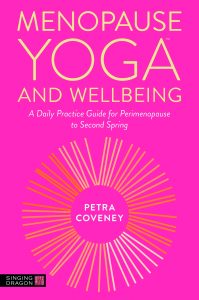
OM meets...
Petra Coveney
Menopause Yoga founder Petra Coveney talks to OM about how yoga can help women embrace their Second Spring
In what ways has yoga influenced or changed your life?
Yoga and specific yoga teachers have guided me through life’s challenges (including parenting, bereavement, divorce and the stages of menopause). Different styles of yoga have helped me heal from physical injuries, provided a philosophical route map for living well, and a joyous sense of community with like-minded people. Yoga teaching helped me find my voice and self-confidence (I used to be too scared to speak in public). Studying to become a yoga therapist gave me deeper understanding of yoga within the Ayurvedic framework, which has changed my approach to working with individual clients. Training Menopause Yoga teachers worldwide and writing two yoga guidebooks has changed my life, fulfilling a sense of purpose and passion in my post menopause. I am deeply grateful and indebted to yoga. I still feel like a student, learning both from the ancient yoga traditions and attending classes with younger teachers who are evolving the practice.
Tell us how Menopause Yoga first came about?
I created Menopause Yoga in 2013 for personal reasons and to help others. I had already come through a difficult perimenopause during which I struggled with symptoms, such as joint and muscle pain, digestive issues, irritability, burn out and hot flushes at night, alongside bereavement, work and relationship issues.
At the age of 44, my doctor confirmed I was in perimenopause but she was reluctant to offer HRT and there was nothing else available, not even a support group. It was the ‘dark ages’ before the growth of social media and the new wave of menopause awareness that came later. Menopause was still a taboo word whispered with embarrassment. None of my friends or family were in menopause and my mother had already passed away, so I had to figure it all out for myself. I felt lost, alone and angry. Why didn’t women like me have more help? Why didn’t we have other women to talk to, to pass on wisdom and knowledge? So, I turned that menopause rage around and focused this energy positively to create a holistic health programme for myself and other women that combined the latest western medical science with the wisdom of eastern wellbeing practices.
As a former BBC producer and national newspaper journalist, I wanted facts not myths and wanted to understand what was happening to my body and hormones. So, I became the first yoga teacher to join the British Menopause Society; it was me surrounded by doctors, scientists and academics. It was quite daunting but gave me access to the latest research. I also researched nutrition, herbal remedies, and psychology because I knew from experience that menopause is about more than just your hormones; it is a biological, psychological, social and potentially soulful transformation. I delved into Ayurveda and traditional Chinese medicine, scoured old yoga texts and books about menopause written in the 1970s and 80s from a radical feminist perspective. I tried and tested some of the yoga methods described in books by Geeta Iyengar, Suza Francina and Dinah Rodrigues, then trialled these with women in my workshops over several years and sought honest, anonymous feedback. From this, I gleaned what doesn’t work or is impractical, what can work and why it works, then created the first holistic health programme that includes these five pillars of Menopause Yoga:
- Specialist yoga classes with poses, meditation and breathwork modified to meet the different needs of people at the different stages of perimenopause, menopause and post menopause.
- Evidence-based factual information about hormones and a basic guide to lifestyle changes.
- A positive reframing of menopause as a woman’s awakening, a Second Spring, a concept from traditional Chinese medicine.
- Women’s circle discussions so that women and people could talk to each other and not feel isolated.
- Journal (swadhyaya) writing for self- reflection because menopause is more than a hormone transition.
It is important to add that over the past 15 years I have added and modified what I teach as we have learned more about the different experiences of women and people in menopause. A one size fits all approach does not work. Both Ayurveda practitioners and the National Institute for Health and Care Excellence (NICE) support an individualised approach tailored to the person’s specific needs. This is why I wrote my second book helping people develop their own daily practice and self-care guide.
“The menopause is not an end – it is a new beginning – a Second Spring. But for some people it may include a wake-up alarm bell…”

In what ways can yoga help women in their menopause journey?
Medical professionals recommend yoga for the menopause because it can help some people to reduce stress, which is a trigger for many other symptoms and side effects, including inflammation, insomnia and fatigue, hot flushes, headaches, joint and muscle pain, mood swings and problems with digestion and genitourinary problems, such as stress incontinence. As we go through menopause, the fluctuating and lower levels of oestrogen make it harder for our body to rebalance the stress hormone cortisol. So, everyday stressors that we used to manage easily before, suddenly feel overwhelming if you add on midlife common stress events such as elderly parent illness, bereavement, juggling childcare, work and relationships.
Low oestrogen may cause vasomotor symptoms such as cold chills or hot flushes, anxiety, heart palpitations. Our brain is being rewired in preparation for the post-reproductive stage of our lives, which is a necessary and natural change – but low oestrogen may hinder the production of our happy, calming hormones (dopamine, serotonin, oxytocin) so we may have mood swings, low mood (anhedonia) and lethargy and become socially withdrawn as a result of low self-confidence. Stress and inflammation also affect the longer-term health risks of weaker bone density (osteoporosis, muscle atrophy, cardiovascular disease, diabetes and dementia). Staying healthy and mobile becomes more challenging as muscle and joint pain such as frozen shoulder, nerve sensitivity such as sciatica, and plantar fasciitis may prevent us from participating in our normal exercise routines. Can yoga ‘cure’ all of these symptoms? No. Yoga is not a magic pill – it is a holistic mind-body-soul practice. And not all styles of yoga are suitable in your menopause, depending on your symptoms.
How would you describe your own teaching style?
I hope my students experience my style of teaching as invitational and empowering, encouraging self-kindness and compassionate always. Invitational because I always offer options and modifications, not just for asana poses, but also the breathwork and meditation. Empowering because I make space for people to have their own experience and learn what yoga techniques work for them, which they can put in their toolkit and which ones they can choose to leave out. Encouraging self-kindness and compassion because many of us are self- critical going through menopause believing we are less than, not enough. We are not broken, we do not need to be fixed. Embracing menopause, accepting and loving our changing bodies, brains and emotions is our menopause superpower. It’s how we ultimately step into our Second Spring. Life becomes lighter and more joyful. You’ll notice Second Springers don’t care what others think. It’s liberating!
What are your future plans?
My new book ‘Menopause Yoga & Wellbeing – a Daily Practice Guide for Perimenopause to Second Spring’ includes over 20 classes and practices accompanied by illustrations, modifications and videos. So, from Winter 2025 – Spring 2026, I will be offering a series of live online sessions focused each week on a different class featured in my new book. The aim is to help people learn the techniques with me before they practice on their own. Then, later in 2026, I will be launching a new level 2 menopause yoga training course for yoga therapists and menopause coaches, so they can use the book’s contents to support their clients. In 2026, I will turn 60 and already have exciting plans for my next decade, more travel, more research and a new CPD course and book in the pipeline. I can’t wait!
What do you do when you’re not working or doing yoga?
I live in Brighton, East Sussex, UK. I teach a weekly Hatha yoga class in Hove for people of all ages and attend younger teachers’ classes, which I love. I also practice qigong, swim in the sea, walk my dog, see friends and family and dance with my ‘boyfriend’ who is a Second Spring soulmate and joyful human being. I feel so lucky to be romantically in love at my age.
What inspires you and keeps you energised and motivated?
A sense of purpose (teaching and writing) and wonder in the world. There is so much I want to explore and experience. And I have two more books that I am researching and writing. I’ve enjoyed my Second Spring in my 50’s but now I’m excited about my next decade, my Second Summer.
Any tips for incorporating yoga into daily life, especially those facing menopause?
We are all busy and as a yoga therapist I know how important it is to make yoga a daily practice, a part of your life. So my new book ‘Menopause Yoga & Wellbeing – a Daily Practice Guide for Perimenopause to Second Spring’ gives women 5-minute, 15-minute and 30-minute meditations, breathwork, asana movement or restorative poses that they can practice any time, place or anywhere (at home, on holiday in a hotel or in your workplace). These are practical, accessible and achievable.
Any final message for OM readers?
The menopause is not an end – it is a new beginning – a Second Spring. For some, it may include a wake-up alarm bell of hormone-related symptoms alerting you to rebalance your life and lifestyle now to support your long-term health. This may require prioritising yourself over others, especially during perimenopause. This is not selfish, it is self-care, and ultimately caring for yourself enables you to look after others. Think of the airplane oxygen mask. This is non-negotiable. If you pause, relax and listen to this alarm bell, your menopause may also be a soulful awakening to your self, a chance to truly find your voice, feel a creative surge to follow new passions or hobbies, adventures and experiences. It is your body’s clock ticking, inviting you to carpe diem — seize the day — and enjoy your life right now. What are you waiting for? Please remember: You are not alone. You are connected to women all over the world who are making the same journey. Menopause Yoga is a holistic therapeutic mind-body-soul practice that you can take with you, a friendly guide through perimenopause to your Second Spring.

Petra Coveney is the founder of Menopause Yoga, launched 2013, and is an acclaimed teacher, trainer, yoga therapist, author and guest speaker, specialising in supporting people through the stages of perimenopause to post menopause which she positively reframes as your Second Spring.
Visit the website: menopause-yoga.com or
connect on Instagram @menopause_yoga
Quick Q&A
Favourite yoga or spiritual book?
Reflections of the Moon on Water: Healing Women's Bodies and Minds Through Traditional Chinese Wisdom. Zhao, Xiaolan. Published by Vintage Books Canada, 2007.
Go-to health food or drink?
Real fresh food (not processed) that includes protein, phytoestrogens, calcium, vitamin B, K, C and D. Flaxseed by Linwood and collagen by Wild Nutrition.
Favourite quote?
These lyrics: “Everything Must Change” sung by George Benson, and “Feeling Good” sung by Nina Simone. Why? Because these lyrics tap into the Buddhist teaching of impermanence; that “everything must changing, nothing and no one stays the same…and that is the way of life.”
This song is helpful for people in perimenopause who don’t feel ready to let go of their reproductive stage of life, or maybe fear the unknown, unsure of what lies on the other side of menopause. It’s understandable; our culture does not value older women. But when we accept change, when we relax into the flow of life’s impermanence, then the struggles drift away and there is space to feel the joy and let new things in. Nina Simone’s song is perfect for women emerging from the cocoon of menopause into their Second Spring. Her lyrics inspire us to step into a new dawn, a new day, a new life – your Second Spring.
“Birds flying high, you know how I feel, Sun in the sky, you know how I feel. Clouds drifting on by that’s how I feel, it’s a new dawn, a new day, a new life for me and I’m feeling good.”
Favourite yoga pose and why?
Restorative Queen Reclined Supported Cobbler Pose (Supta Baddha Konasana) for cooling hot flushes. It has to be the Queen version with lots of props to physically make you feel like a Queen and emotionally supported in this stage of life.


